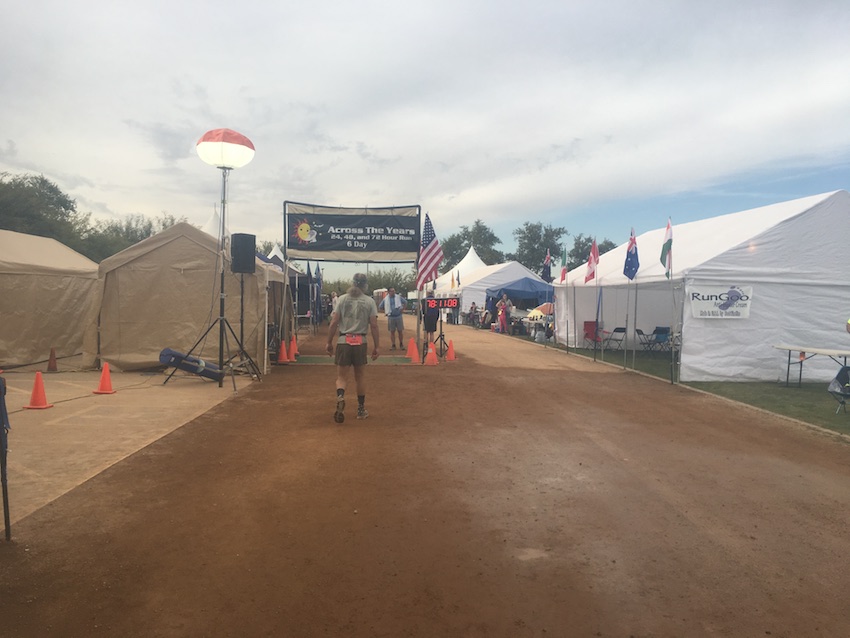
Early this morning I walked off the one mile track in Phoenix Arizona where the Across the Years Ultra Race was taking place. Everybody who was running on the track with me was testing their limits to see how any miles they can rack up during 24, 48, 72 and 144 hours of running. My own interest was in being the first person to set a record for running multiple marathons using zero calories. I was successful in racking up just over 76 miles (almost three marathons) in less than 24 hours with no caloric intake during that time. I’m not suggesting that anyone try such a long fasted run, but I think the process of reaching this level of metabolic control might be interesting to others.
I made use of the following biohacking practices to pull off this run:
- DNA Testing – Confirm marker for fat burning
- Daily intermittent fasting averaging 19 hours daily for the last three months
- Physiology Lab RQ (respiratory quotient) Testing – Confirm heart rate matches Niko Niko Pace and Phinney / Volek Number
- Keeping Up Energy Levels – Caffeine, electrolytes and blood glucose / blood ketone testing
DNA Analysis
The PPARA gene was my primary concern when taking on an event that requires me to stay in a catabolic state. Half the population has it and I was fortunate enough to have two copies of the ‘GG’ fat burning allele.
A common genotype in elite endurance athletes, GG individuals have higher levels of PPARA protein in their skeletal muscles on average. As PPARA turns on genes that shift our metabolism to more energy-e cient fat burning, this genotype is perfect for those undertaking endurance-oriented activities.
Via FitnessGenes

Daily Intermittent Fasting
Everyday I test my blood glucose and blood ketones as these are indicators of fat burning. What I have noticed from tracking daily fasting hours is that the longer I fasted each day the lower my blood glucose was and higher blood ketones. In my case 19 hours of fasting and 5 hours of eating seems to be optimal in terms of a comfortable daily practice with good blood numbers.

Staying with a low carb diet with macros of 78% fat, 11% protein and 11% carbohydrates appears to be where my blood ketones have peaked.
Physiology Lab RQ Testing

Most University Physiology Labs have the ability to do an RQ test (respiratory quotient). This test is a good way to learn the ratio of fuels you are burning. In my case I wanted to see confirmation that the heart rate ideal heart rate for me to run at matched across three different sources. The RQ test I did earlier this year at the University of New Mexico provided just that.

This above chart is a result of the RQ test that suggest if I keep my heart rate below 118 BPM I can keep my fat burn above 90%. The big unknown with running multiple fasted marathons was where is the other 10% going to come from later on in the race? The best part about this chart is that the peak fat burning heart rate matches up with two other popular formulas for maximum fat burn exercise.
- Phinney and Volek – Suggest a 64% of VO2Max for maximum fat burn. My VO2Max was 184 when tested at a physiology lab. 184 * .64 =117.76 or 118 BPM
- Hiroaki Tanaka the author of “Slow Jogging” suggests the following formula:
- 138 – (AGE / 2) =[ Niko Niko Heart Rate ]
- In my case I get another match:
- 138 – (40 / 2) = 118.
Having both general formulas match up with the RQ test gave me the confidence to train at a max heart rate of 118 for the last three months. This is the heart rate that I slow jogged the 100 mile fasted run at.

Keeping Up Energy Levels:
The final challenge in the race was to keep my energy levels at a suitable level for an entire day. While I did not take in any calories this still left room for water, electrolytes and caffeine. I took a home made magnesium, potassium and sodium solution ever 2 hours. I also took a “Sprint” caffeine tab mixed with l-theanine and B-Vitamins every 4 hours. I’ve found the cramping to be unbearable unless I continuously take the electrolyte mixture. Checking my glucose and ketone levels every two hours confirmed that I was running at the right pace to produce enough ketones for this event.
